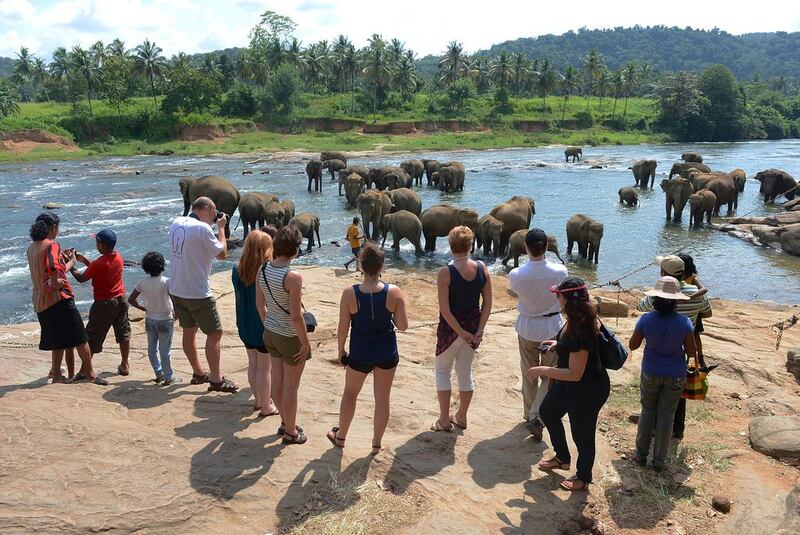On the seafront of Sri Lanka’s largest city, Colombo, tourists lounge on the terrace of a plush five-star hotel and sip their drinks against the backdrop of a mellow sunset.
It is hard to tell on the surface that the country only in 2009 emerged from a civil war that lasted 26 years.
Since the end of the conflict, tourism to the Indian Ocean island, which is rich in culture and nature and boasts idyllic beaches, has surged as travel warnings were lifted and flights into the country resumed.
“Occupancy levels have been improving year on year,” says Kavita Devi Faiella, the executive assistant manager of the Amangalla hotel, nestled in the historic fort city of Galle, a few hours south of the capital.
The fort is a Unesco world heritage site and popular destination in the south of Sri Lanka. The hotel, which advertises its rooms at between US$550 and $1,200 a night, is bustling with guests.
Figures from the Sri Lanka Tourism Development Authority show that 727,353 tourists arrived in the country in the first six months of this year, up almost 25 per cent on the number of visitors in the first half of last year. The vast majority of tourists come from western Europe, the data shows.
“The largest percentage of our guests are Brits, followed by Australia,” says Ms Faiella. “The United States in the last year has become the third biggest market. I think it takes a country a certain amount of time to be safe and not have any issues before American travellers feel confident.
“I think with the civil war having been over for a while now and the tsunami well in people’s history, people really trust the destination now.”
The hotel opened under the management of the international hospitality group Aman just days before the devastating tsunami hit Sri Lanka in 2004.
Tourism revenues are becoming increasingly important to the country, which has set a target of attracting 2.5 million visitors annually by 2016 — double the number it received last year.
Sri Lanka has identified tourism as one of the main sectors to boost the economy with the aim of securing annual foreign exchange earnings of $2.75 billion by 2016, while 500,000 are expected to depend on the industry for jobs by that year.
Tens of thousands of people were killed during the civil war and the country’s economy was hard hit as the Tamil Tigers, a militant group, fought for the creation of an independent state in the north of the island.
Improved infrastructure in the country over the past couple of years, including freeways, are playing a massive role in boosting tourism by making it much easier and quicker to travel around the country.
Popular tourist circuits in Sri Lanka take in the country’s cultural triangle, including the city of Kandy, visiting the tea plantations in the central highlands and heading to the beaches and the historic port city of Galle.
“Highways, roads are improving around the country,” says Henry Fitch, the managing director of the Wallawwa, a luxury boutique hotel in a former colonial manor house in Kotugoda, near Colombo’s airport. “I think that will always mean there will be return guests.”
Mr Fitch says that the property has become increasingly popular among expats visiting from the UAE and the wider Middle East region.
“There has been an increase, particularly at this time of year as the heat is picking up in the Middle East and Ramadan is on,” he says.
Occupancy levels at the hotel have been rising, he says, reaching about 90 per cent in the peak season earlier this year compared with about 86 per cent during the same time last year.
“I think now there’s been so much publicity in the press in terms of tourism what a great place it is,” Mr Fitch says. “It is more suited to independent tourists who are a bit more adventurous. There’s such a diversity in the country and everything’s so close together.”
The number of UAE residents holidaying in Sri Lanka was 2,716 tourists in the first five months of the year, up 55.6 per cent compared with the same period last year, according to the Sri Lanka Tourism Development Authority.
The number of Chinese visitors also surged, up 139.6 per cent to 43,885 tourists between January and May compared with the same months last year. Tourist numbers from Russia were up 77.4 per cent.
“Very few tourists came during the civil war,” says Aman Mohomad, who runs a colonial villa guesthouse property in Galle fort. “There was no business at all in the north. Everything was totally closed. Now they’re putting up modern hotels in the north. The new market is the Chinese market. Every year it’s improving.”
Growth in the number of flights into Sri Lanka has played a significant role in the tourism industry’s rise. Etihad Airways relaunched flights to Sri Lanka in early 2010 after the conflict ended and it has increased its number of services in the country since, doubling its flights into Sri Lanka in February. It also codeshares with Sri Lanka’s national airline.
Emirates Airline last year added more flights to the island to meet growing demand, while flydubai also increased its services to Sri Lanka last summer.
International hotel operators are also aiming to capitalise on Sri Lanka’s growing tourism industry. Major hotel chains largely exited the country during the civil war, which has allowed boutique properties and local operators to thrive. But now the big players are starting to pile in.
A Hyatt in Colombo is nearing completion. Shangri-La and Sheraton hotels are also planned for the city. A Marriott resort has also been announced for the southern coast. Onyx Hospitality, based in Thailand, a few weeks ago opened a hotel in Colombo under its Ozo brand and is planning to launch more properties in the country.
“Almost every international player, they all moved out during the conflict,” says Amal Goonetilleke, the regional director for sales for Taj Hotels, explaining that the Indian hotel company remained in the country throughout the war because the group saw a “great opportunity for Sri Lanka in terms of tourism”.
“It was a very tough time — travel bans, bomb scares,” she says. Taj now manages three hotels in Sri Lanka, including a five-star property in Colombo and a resort under its Vivanta brand in Bentota, a popular tourist spot on the southern coast.
Taj recently spent $50 million renovating its hotels in Sri Lanka, as the group readies the properties for competition.
“That will be the biggest challenge,” says Ms Goonetilleke.
But others point out that big hotel chains will help to promote Sri Lanka as a destination.
“You need to have that development of more luxury properties,” says Ms Faiella. “More brands will make travellers trust the destination more. I think what we’re seeing now is more luxury international brands coming in and that will probably — what we hope — tip the scale a little bit more to Sri Lanka being known as a luxury destination as well as just a new avant-garde ‘have you been to Sri Lanka?’ voyager-type destination.”
business@thenational.ae
Follow us on Twitter @Ind_Insights





